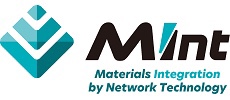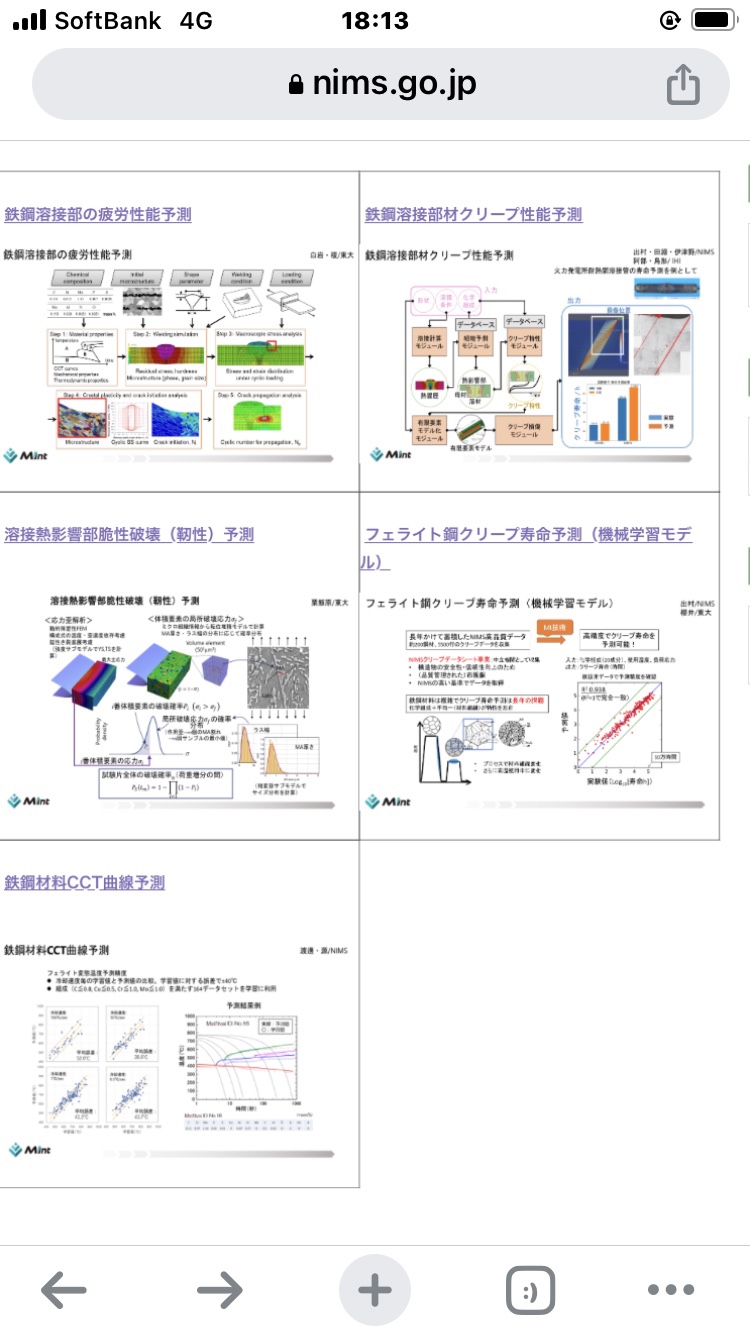

NIMS: New Materials Development System “MInt”!
– MInt (Materials Integration by Network Technology) –
ーStrengthening international competitiveness in materials development in Japanー
MInt of NIMS:
– MInt (Materials Integration by Network Technology) –
Japan aims to further strengthen its international competitiveness in materials development.
What is MInt:
A new material development system that analyzes and calculates the structure formation inside materials.
phase field method,
Predictive models for material strength, etc.
It has various algorithms.
Multiple Algorithms:
Solve with an “analysis program that combines multiple algorithms”.
Forward problem analysis:
Predict physical properties such as strength and density from material composition.
Inverse problem analysis:
Analyze the production conditions and composition process to obtain the desired performance.
Conventional materials informatics:
It differs from materials informatics (MI), which improves individual materials and products.
National Institute for Materials Science (NIMS):
The National Institute for Materials Science (NIMS) announced as follows.
– Heating Process in Aging Treatment of Nickel (Ni)-Based Superalloys –
After being roasted at a high temperature, it is slowly baked at a low temperature, just like a cooking guide.
What is aging treatment:
After molding metal parts by powder forging or additive manufacturing,
A process that increases strength by heating and holding at a high temperature of several hundred degrees Celsius.
MInt computes the pattern:
MInt, a system for structural metal materials, has derived the “optimal heating pattern from 3.5 billion patterns.”
“It’s over 100 times faster than experimenting.”
Examples of aging treatment:
-Extreme combination of heating temperature and time-
AI analyzes the optimal aging treatment process for the heating pattern that maximizes the strength (inverse problem analysis)
Conventional aging treatment:
In the first place, aging treatment was generally performed at a single temperature.
In the experiment, it takes more than half a month to try one heating pattern.
Mint aging treatment:
However, the approach using MInt dramatically increased the number of trials.
A new process of “changing the heating temperature in chronological order” has become possible.
NIMS Integrated Materials Development
Head of Information Infrastructure Division
Mr. Masahiko Demura
With MInt, one heating pattern can be calculated within half a day.
This is more than 100 times faster than previous experimental studies.
Purpose of MInt development:
The purpose is to strengthen the international competitiveness of Japan’s materials development.
A clear distinction from conventional MI.
By devising the structure and operation method of the system, we will win the development competition with the world.
Nikkei Cross Tech (xTECH)
https://xtech.nikkei.com/atcl/nxt/mag/nmc/18/00011/00208/
MInt System Catalog | Integrated Materials Development and Information Infrastructure Division
https://www.nims.go.jp/MaDIS/MIconso/catalog.html
Material Revolution by Integrated Materials Development System” List of original papers (end of March 2023))
https://www.jst.go.jp/sip/dl/p05/p05_research_paper.pdf
NIMS : nouveau système de développement de matériaux « MInt » !
– MInt (Intégration de Matériaux par Technologie de Réseau) –
ーRenforcement de la compétitivité internationale dans le développement des matériaux au Japonー
Mint du NIMS :
– MInt (Intégration de Matériaux par Technologie de Réseau) –
Le Japon vise à renforcer davantage sa compétitivité internationale dans le développement des matériaux.
Qu’est-ce que la menthe :
Un nouveau système de développement de matériaux qui analyse et calcule la formation de la structure à l’intérieur des matériaux.
méthode du champ de phase,
Modèles prédictifs pour la résistance des matériaux, etc.
Il a divers algorithmes.
Algorithmes multiples :
Résolvez avec un “programme d’analyse qui combine plusieurs algorithmes”.
Analyse du problème en avant :
Prédisez les propriétés physiques telles que la résistance et la densité à partir de la composition des matériaux.
Analyse du problème inverse :
Analyser les conditions de production et le processus de composition pour obtenir les performances souhaitées.
Informatique des matériaux conventionnels :
Elle diffère de l’informatique des matériaux (MI), qui améliore les matériaux et les produits individuels.
Institut national des sciences des matériaux (NIMS) :
L’Institut national des sciences des matériaux (NIMS) a annoncé ce qui suit.
– Processus de chauffage dans le traitement de vieillissement des superalliages à base de nickel (Ni) –
Après avoir été torréfié à haute température, il est cuit lentement à basse température, à la manière d’un guide de cuisson.
Qu’est-ce que le traitement du vieillissement :
Après moulage de pièces métalliques par forgeage des poudres ou fabrication additive,
Un processus qui augmente la résistance en chauffant et en maintenant à une température élevée de plusieurs centaines de degrés Celsius.
MInt calcule le modèle :
MInt, un système pour les matériaux métalliques structuraux, a dérivé le “modèle de chauffage optimal à partir de 3,5 milliards de modèles”.
“C’est plus de 100 fois plus rapide que l’expérimentation.”
Exemples de traitement anti-vieillissement :
-Combinaison extrême de température de chauffage et de temps-
L’IA analyse le processus de traitement de vieillissement optimal pour le modèle de chauffage qui maximise la résistance (analyse du problème inverse)
Traitement anti-vieillissement conventionnel :
En premier lieu, le traitement de vieillissement était généralement effectué à une seule température.
Dans l’expérience, il faut plus d’un demi-mois pour essayer un modèle de chauffage.
Traitement vieillissant à la menthe :
Cependant, l’approche utilisant MInt a considérablement augmenté le nombre d’essais.
Un nouveau processus de “modification de la température de chauffage dans l’ordre chronologique” est devenu possible.
Développement de matériaux intégrés NIMS
Chef de la division Infrastructure de l’information
M. Masahiko Demura
Avec MInt, un modèle de chauffage peut être calculé en une demi-journée.
C’est plus de 100 fois plus rapide que les études expérimentales précédentes.
Objectif du développement de MInt :
L’objectif est de renforcer la compétitivité internationale du développement des matériaux au Japon.
Une nette distinction par rapport à l’IM classique.
En concevant la structure et la méthode de fonctionnement du système, nous gagnerons la compétition de développement avec le monde.
Nikkei CrossTech (xTECH)
Catalogue du système MInt | Département du développement intégré des matériaux et de l’infrastructure de l’information
Material Revolution by Integrated Materials Development System » Liste des articles originaux (fin mars 2023)
NIMS: Neues Materialentwicklungssystem „MInt“!
– MInt (Materialintegration durch Netzwerktechnologie) –
ーStärkung der internationalen Wettbewerbsfähigkeit in der Materialentwicklung in Japanー
MInt von NIMS:
– MInt (Materialintegration durch Netzwerktechnologie) –
Japan will seine internationale Wettbewerbsfähigkeit in der Materialentwicklung weiter stärken.
Was ist Mint:
Ein neues Materialentwicklungssystem, das die Strukturbildung im Inneren von Materialien analysiert und berechnet.
Phasenfeldmethode,
Vorhersagemodelle für Materialfestigkeit etc.
Es hat verschiedene Algorithmen.
Mehrere Algorithmen:
Lösen Sie mit einem “Analyseprogramm, das mehrere Algorithmen kombiniert”.
Vorwärtsproblemanalyse:
Prognostizieren Sie physikalische Eigenschaften wie Festigkeit und Dichte anhand der Materialzusammensetzung.
Inverse Problemanalyse:
Analysieren Sie die Produktionsbedingungen und den Zusammensetzungsprozess, um die gewünschte Leistung zu erzielen.
Konventionelle Werkstoffinformatik:
Sie unterscheidet sich von der Materialinformatik (MI), die einzelne Materialien und Produkte verbessert.
Nationales Institut für Materialwissenschaften (NIMS):
Das National Institute for Materials Science (NIMS) gab Folgendes bekannt.
– Erwärmungsprozess bei der Alterungsbehandlung von Superlegierungen auf Nickel(Ni)-Basis –
Nachdem es bei hoher Temperatur geröstet wurde, wird es wie eine Kochanleitung langsam bei niedriger Temperatur gebacken.
Was ist Alterungsbehandlung:
Nach dem Formen von Metallteilen durch Pulverschmieden oder additive Fertigung,
Ein Prozess, der die Festigkeit durch Erhitzen und Halten bei einer hohen Temperatur von mehreren hundert Grad Celsius erhöht.
MInt berechnet das Muster:
MInt, ein System für strukturelle Metallwerkstoffe, hat das „optimale Erwärmungsmuster aus 3,5 Milliarden Mustern“ abgeleitet.
“Es ist über 100-mal schneller als zu experimentieren.”
Beispiele für Alterungsbehandlungen:
-Extreme Kombination aus Heiztemperatur und -zeit-
KI analysiert den optimalen Alterungsbehandlungsprozess für das Erwärmungsmuster, das die Festigkeit maximiert (inverse Problemanalyse)
Konventionelle Alterungsbehandlung:
An erster Stelle wurde die Alterungsbehandlung im Allgemeinen bei einer einzigen Temperatur durchgeführt.
Im Experiment dauert es mehr als einen halben Monat, um ein Heizmuster auszuprobieren.
Minze-Aging-Behandlung:
Der Ansatz mit MInt erhöhte jedoch die Anzahl der Studien dramatisch.
Ein neuer Prozess der „Änderung der Heiztemperatur in zeitlicher Reihenfolge“ ist möglich geworden.
NIMS Integrierte Materialentwicklung
Leiter der Abteilung Informationsinfrastruktur
Herr Masahiko Demura
Mit MInt kann innerhalb eines halben Tages ein Heizverlauf berechnet werden.
Dies ist mehr als 100-mal schneller als frühere experimentelle Studien.
Zweck der MInt-Entwicklung:
Ziel ist es, die internationale Wettbewerbsfähigkeit der japanischen Materialentwicklung zu stärken.
Eine klare Abgrenzung zum konventionellen MI.
Indem wir die Struktur und die Betriebsmethode des Systems entwickeln, werden wir den Entwicklungswettbewerb mit der Welt gewinnen.
Nikkei Cross Tech (xTECH)
MInt-Systemkatalog | Abteilung Integrierte Materialentwicklung und Informationsinfrastruktur
Material Revolution by Integrated Materials Development System“ Liste der Originalarbeiten (Ende März 2023)